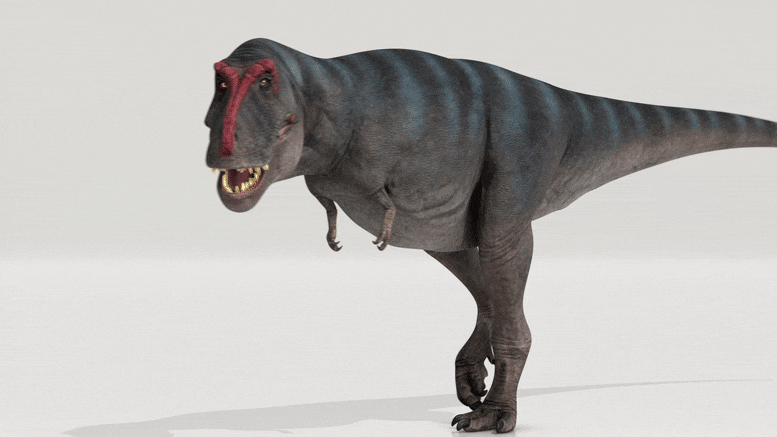

Trix’s skeleton at Naturalis Biodiversity Center. Credit: Mike Bink
Humans and animals have a preferred walking speed. This is partly influenced by the amount of energy required: they prefer to run at the speed at which they use as little energy as possible. One of the ways to achieve this is by using resonance.
You already know how it works: when you’re swinging, you can’t just swing at any speed. If you want to do it right, you need to have the timing right and swing to the beat of the swing. In other words, you have to resonate with it. And when you take a nice, relaxing walk, the parts of your body resonate too. Walking a little slower does not use less energy: you notice that it is actually more difficult.
An animation of T.rex Trix running according to the simulations in Van Bijlert et al. 2021. The tail resonates, allowing for a more realistic, slightly slower gait. Credit: Rick Stikkelorum, Arthur Ulmann & Pasha van Bijlert
This works for animals that walk within four feet, and for two-legged animals such as humans and ostriches. Pasha van Bijlert, student of Human Movement Sciences at the Free University in Amsterdam (VU), applied the idea to an animal that walked differently from what is currently walking around on Earth: Tyrannosaurus rex. These carnivorous dinosaurs not only had two legs, they also had a huge tail that helped them move.

Student Pasha van Bijlert with a replica of Trix, the Tyrannosaurus rex that he modeled as part of his thesis. Credit: Tom Brown
Like the bones in our necks, the bones are held together in tails by ligaments. “You could compare it to a suspension bridge,” explains Van Bijlert. “A suspension bridge with a lot of muscle in it.” Each step swings the tail up and down. That means that, like the swing, it has a natural frequency to which it resonates.
To find out what that frequency is, Van Bijlert and his professors Anne Schulp (Naturalis / Utrecht University) and Knoek van Soest (VU) built a 3D model of Trix, the Tyrannosaurus rex, on display at the National Natural History Museum. Naturalis. They added digital muscles to the famous skeleton, and they were able to perform biomechanical analyzes on this muscle model. From this they derived the natural frequency and a desired walking speed: 4.6 km / h (2.9 mph). So when Trix was out walking, she was walking at about the same speed as you. If you had a T. rex as a pet, you wouldn’t have a problem walking it – at least in terms of speed.
Van Bijlert, Van Soest and Schulp published their findings in the journal Royal Society Open Science today (April 21, 2021). “There were already some studies that investigated the walking speed of dinosaurs, but they mainly looked at the legs and ignored the tail – that’s what makes dinosaurs so unique,” says Van Bijlert. “They usually found much faster walking speeds. The one we calculated is lower, but similar to that of other animals. “
Reference: “Natural Frequency Method: estimating the preferred walking speed of Tyrannosaurus rex based on tail natural frequency ”by Pasha A. van Bijlert, AJ ‘Knoek’ van Soest and Anne S. Schulp, 21 April 2021, Royal Society Open Science.
DOI: 10.1098 / rsos.201441